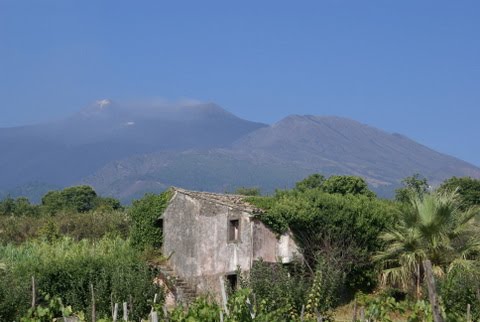On the Etna (2)
Posted on 6 September 2009
My second day on the Etna was at Vinimilo, a wine tasting event that’s been organised in Milo, a somewhat seedy town on the eastern slope of the volcano, for no less than 26 years. This edition is dedicated to the alberello – the bush vine that is the classic vineyard cultivation method around the Mediterranean. It doesn’t sound earth-shakingly interesting to the wine novice but some of the wines on show were very exciting. Bush vine cultivation requires a lot of manual work and so is usually embraced by high-end producers that often have an organic approach.
No wonder many wines were very individual. Some excessively so (the unsulphured Sardinians from the Pane Vino estate failed to thrill me), and some controversial (the Primitivos from La Morella have more than 15.5% alcohol and despite their expressive fruit, are inevitably very heady). But there were gems, too, such as the sweet Passito 2005 from the tiny island of Pantelleria made by Salvatore Ferrandes, bursting with candied orange and mineral freshness at the same time, or the serious, nocturnal, powerful Olevano Romano Cesanese Cirsium 2005 from micro-producer Damiano Ciolli south of Rome. I also liked the unsophisticated but distinctive and delicious duo of Rossese wines from Maixei, a mini-coop in Dolceacqua in western Liguria, near the French border. Rossese is an ancient grape that only grows on some 100 ha, all on high-perched terraces with bush vines. The viticulture here is so labour-intensive that Rossese as a whole is an endangered species; I just wish it can survive as its profile is really distinctive.
There were also some brilliant non-Mediterranean wines, such as the bush vine-trained Sangioveses from Fattoria Zerbina in Romagna (the 2006 Pietramora is a monster that will live at least two decades) and the amazingly mineral (and surprisingly unalcoholic) Vitovskas from eastern Friuli’s Vodopivec, including a clay amphora-macerated 2005 that is a masterpiece of balance.
In the end I tried to concentrate on Sicilian wines and especially those from Etna. (This included a tasting of local bottlings for the wider public that took place the following day). It’s not so obvious to find really good wine on the volcano. While the reds generally have the crisp, crunchingly tannic signature of the local grape – Nerello Mascalese – and terroir, there’s a lot of excessive yields and poor winemaking around, resulting in unbalanced, over-tannic wines that lack fruit. Stuff from Michele & Mario Grasso and Terre Grasso Salina is simply disastrous while Don Saro, Cantine del Regno, Maria Di Bella, Barone di Villagrande are generally uninspiring.
Good Etna wines come in a variety of styles: the red from Il Cantante (an estate belonging to the Simply Red frontman, Mick Hucknall) sees a lot of wood and a long ageing in bottle; the 2002 is rich, brooding, evolved but with plenty of power left, and an interesting wine. Fierce tannins are also the hallmark of Tenute Romeo del Castello whose Etna Rosso In Attesa d’Artista 2007 is overextracted but shows good minerality. Agostino Sangiorgi makes a few thousand bottles of a single wine, Granaccio, on the southern outskirts of the appellation; it’s a very pale wine (there are some white grapes in the blend) that is really elegant but also fiercely acidic, and will need time in the bottle too. I liked the unexaggerated fruit and distinctive spice of the Etna Rosso Valcerasa 2005 from Alice Bonaccorsi, though it’s hardly very complex. The red Etna DOC from Aítala is a bit heavy-handed but the IGT Nerello Mascalese 2007 is one of the more succulent interpretations of the Etna grape.
With top estates such as Tenuta delle Terre Nere and Passopisciaro missing, the memorable wines came from Ciro Biondi (as much the ambitious single-vineyard MI 2007 as the cheaper Outis 2006, a stylish wine with a sense of digestness and classicism that I would gladly drink anytime) and the ubiquitous Benanti, Etna’s major player, whose top bottlings both in white (Pietramarina 2005: very shy, deep, half-mineral, saline) and red (Serra della Contessa 2004: serious concentration, good minerality, calm, a little soft perhaps) I have enjoyed more in other circumstances but even here they showed obvious substance and dimension that put them above the bunch.
We tasted more Etna wines from a group of estates originated by Salvo Foti, a viticulturalist that is one of Etna’s major characters – more on these tomorrow.


